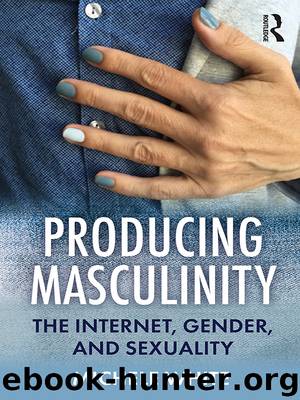Producing Masculinity by Michele White;

Author:Michele White;
Language: eng
Format: epub
Publisher: Taylor & Francis (CAM)
Men’s Natural Look Tutorials and Masculinity
Popular culture, including reporting on beauty vlogging, indicates that beauty texts are more appropriate for women. For instance, the women-oriented SheKnows lists, “11 Addicting YouTube channels for beauty how-tos” that only includes women vloggers.47 According to CarrieLynn D. Reinhard’s analysis of cross-gendered media, “expectations of gender appropriateness have been structured into numerous aspects of U.S. society.”48 In addition, I would argue that these gendered organizations are part of other Western cultures. There are “media products produced ‘for him’ or ‘for her’” and individuals “may feel most comfortable engaging with the media meant for them.” Thus media texts, in a similar manner to clothes, are supposed to be produced for and best when engaged by appropriately gendered bodies. To make normative men feel comfortable engaging with beauty videos, producers of men’s natural look tutorials emphasize their male audience. For example, Colin Jay provides a “Natural ‘No Makeup’ Makeup Tutorial for Men.”49 The Beauty Boy’s chosen alias suggests that there is a relationship between men, boys, and aesthetics. He refers to posters as “fella.”50 badboosh offers a “video for the boys.”51 Yet Beauty Boy is credited with initiating the #MakeupIsGenderless hashtag that appears in other vloggers’ statements. His reformulation of men’s relationship to cosmetics is one of the reasons that he was chosen as a spokesperson for L’Oréal.52 Of course, terms like “boys” sustain youthful positions and correlate vloggers and viewers with queer children who refuse to normatively grow up.53 Through such structures, producers decline cultural mandates for men to pursue traditional life trajectories and move towards adulthood.
When the men who produce natural look videos overtly assert that they are men, they acknowledge that their normative gender positions are challenged. In her chapter on deconstructive reading, Barbara Johnson considers when texts protest too much.54 Such protestations occur when Jay stresses that he is “male.”55 Jay also performs this excessive gender management through visual methods. He cosmetically makes his eyebrows look “boyish” because he plucks them rather thinly. In such cases, tutorial producers suggest that men’s gender is compromised by beauty practices, such as plucking eyebrows, while also assuring viewers that gender positions can be resolved through related procedures. Producers and viewers may be more comfortable when gender ruptures are resolved but men’s natural look makeup tutorials continue to generate inconsistencies. As a means of grappling with these issues, producers evaluate and hierarchize cosmetic practices, with some procedures being deemed more endangering to masculinity. For instance, Welsh’s dos and don’ts provide a gender schema. He states, “no mascara” because it is “ultra feminine” and makes your “lashes look a little too much.” Too much is linked to excess and correlated with the too feminine and masquerades but it is also associated with too many protestations.
Vloggers excessively protest when they use health narratives to explain their employment of makeup. Men reference acne and other skin “problems” as a means of explaining the functions of tutorials, clarifying men’s employment of cosmetics, and reworking the association of cosmetics with too much.
Download
This site does not store any files on its server. We only index and link to content provided by other sites. Please contact the content providers to delete copyright contents if any and email us, we'll remove relevant links or contents immediately.
Rewire Your Anxious Brain by Catherine M. Pittman(17608)
Talking to Strangers by Malcolm Gladwell(11927)
The Art of Thinking Clearly by Rolf Dobelli(8882)
Mindhunter: Inside the FBI's Elite Serial Crime Unit by John E. Douglas & Mark Olshaker(7860)
Becoming Supernatural by Dr. Joe Dispenza(7131)
Change Your Questions, Change Your Life by Marilee Adams(6675)
The Road Less Traveled by M. Scott Peck(6661)
Nudge - Improving Decisions about Health, Wealth, and Happiness by Thaler Sunstein(6651)
The Lost Art of Listening by Michael P. Nichols(6496)
Enlightenment Now: The Case for Reason, Science, Humanism, and Progress by Steven Pinker(6425)
Win Bigly by Scott Adams(6334)
Mastermind: How to Think Like Sherlock Holmes by Maria Konnikova(6264)
The Way of Zen by Alan W. Watts(5818)
Daring Greatly by Brene Brown(5669)
Grit by Angela Duckworth(4753)
Big Magic: Creative Living Beyond Fear by Elizabeth Gilbert(4744)
Men In Love by Nancy Friday(4355)
Flow by Mihaly Csikszentmihalyi(4072)
The Four Tendencies by Gretchen Rubin(4035)
